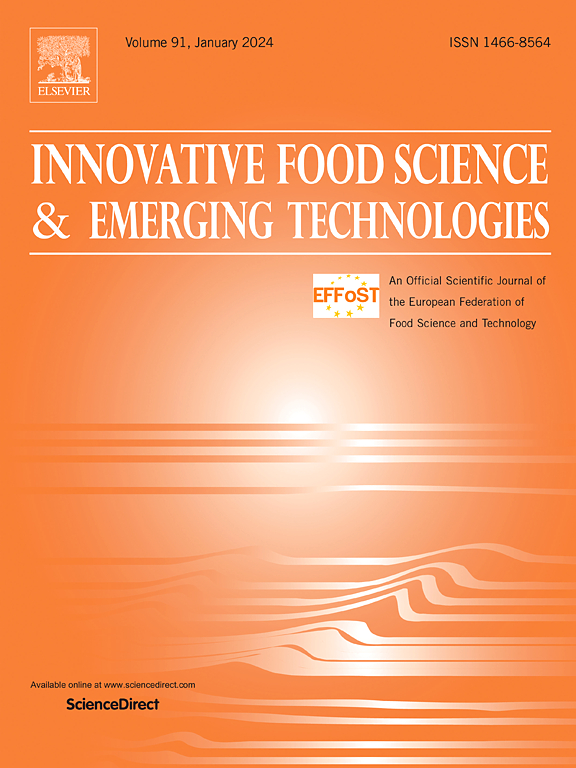Application of dietary fibers as hydrocolloids: Experimental evaluation in a model processed cheese sauce system
IF 6.3
1区 农林科学
Q1 FOOD SCIENCE & TECHNOLOGY
Innovative Food Science & Emerging Technologies
Pub Date : 2025-07-22
DOI:10.1016/j.ifset.2025.104121
引用次数: 0
Abstract
This study investigates the impact of dietary fibers (beetroot or carrot) on the surface texture, rheological behavior, and stability of processed cheese sauces made with different fat sources: anhydrous milk fat (AMF), organic coconut oil (OCO), or rapeseed oil (RO). Surface roughness (Ra, Rq, Rt) was analyzed using optical profilometry, and emulsion stability was evaluated via Turbiscan Stability Index (TSI). Optical microscopy enabled qualitative assessment of droplet distribution, while rheological parameters—storage modulus (G′), loss modulus (G″), and viscosity—were measured alongside instrumental texture properties (hardness, adhesiveness, cohesiveness). Results showed that both fiber type and concentration significantly influenced all analyzed parameters. Beetroot fiber at 1 % in OCO-based sauces produced the highest surface roughness, which decreased at 4 % fiber concentration, indicating improved homogenization. Carrot fiber at 4 % also contributed to a smoother surface. TSI revealed highest instability in AMF-based samples with 3 % carrot fiber, while 4 % fiber improved stability. A correlation was found between surface roughness and instability. AMF-based samples displayed the highest G′, suggesting a more robust elastic network, with beetroot fiber enhancing elasticity more effectively. All fiber-enriched sauces showed shear-thinning behavior, with highest viscosity observed in AMF-based sauces containing 4 % fiber. Texture analysis confirmed that increasing fiber concentration enhanced firmness and cohesiveness. Overall, fiber type and concentration, along with fat source, are key to optimizing the structural and functional properties of processed cheese sauces, supporting the formulation of fiber-enriched emulsified foods.
膳食纤维作为水胶体的应用:在模型加工奶酪酱体系中的实验评价
本研究调查了膳食纤维(甜菜根或胡萝卜)对由不同脂肪来源(无水乳脂(AMF)、有机椰子油(OCO)或菜籽油(RO))制成的加工奶酪酱的表面质地、流变行为和稳定性的影响。采用光学轮廓法分析表面粗糙度(Ra, Rq, Rt),并通过Turbiscan稳定性指数(TSI)评估乳液稳定性。光学显微镜可以对液滴分布进行定性评估,而流变参数-储存模量(G '),损失模量(G″)和粘度-与仪器纹理特性(硬度,黏附性,黏性)一起测量。结果表明,纤维类型和浓度对各分析参数均有显著影响。甜菜根纤维浓度为1%时,表面粗糙度最高,纤维浓度为4%时,表面粗糙度降低,表明均质性得到改善。4%的胡萝卜纤维也有助于光滑的表面。在含有3%胡萝卜纤维的amf基样品中,TSI显示出最高的不稳定性,而含有4%胡萝卜纤维的样品则提高了稳定性。发现了表面粗糙度和不稳定性之间的相关性。基于amf的样品显示出最高的G′,表明甜菜根纤维更有效地增强弹性,弹性网络更坚固。所有富含纤维的酱汁都表现出剪切变薄的行为,在含有4%纤维的amf基酱汁中观察到最高的粘度。织构分析证实,增加纤维浓度可增强纤维的硬度和粘结性。总的来说,纤维的种类和浓度,以及脂肪的来源,是优化加工奶酪酱的结构和功能特性的关键,支持了富含纤维的乳化食品的配方。
本文章由计算机程序翻译,如有差异,请以英文原文为准。
求助全文
约1分钟内获得全文
求助全文
来源期刊
CiteScore
12.00
自引率
6.10%
发文量
259
审稿时长
25 days
期刊介绍:
Innovative Food Science and Emerging Technologies (IFSET) aims to provide the highest quality original contributions and few, mainly upon invitation, reviews on and highly innovative developments in food science and emerging food process technologies. The significance of the results either for the science community or for industrial R&D groups must be specified. Papers submitted must be of highest scientific quality and only those advancing current scientific knowledge and understanding or with technical relevance will be considered.

 求助内容:
求助内容: 应助结果提醒方式:
应助结果提醒方式:


